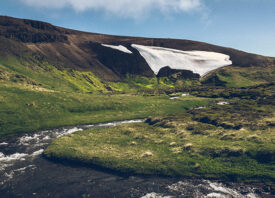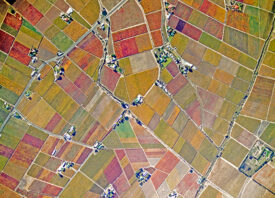Search this site
This Company Is Helping NFT Artists Offset Their Carbon Footprints

The photographer and creative technologist Ebby Amir recently took a trip to Hawaii’s Kalalau Trail. “It was unspeakably beautiful–something that you’d just die to see,” he tells me. “I took thousands of photographs, but I got one panorama of the sunset that captured the journey. It’s one of those shots that made me sit back and think, ‘Wow, that is a gorgeous piece of planet Earth right there. And we only have one planet.’”
For photographers like Amir, who prioritize sustainability, the last year has presented a dilemma: even as non-fungible tokens opened the door to new professional opportunities, they brought with them a hidden environmental cost. That’s because the Ethereum blockchain, the network that powers the majority of NFTs, currently runs on an energy-intensive consensus mechanism called “proof of work.”
Though the numbers vary, research indicates that the creation of an average NFT has a carbon footprint equivalent to driving 500 miles in a gasoline-powered car. According to Aerial, a sustainability company Amir co-founded, the sale of the Otherside metaverse by Yuga Labs had emitted over 25,000 tonnes of CO2 by May 1st. “That’s roughly the annual emissions of 5,400 cars or 41,000 round trip flights from San Francisco to New York,” Amir shared on Twitter.
Aerial is an app that helps users offset their carbon emissions. Amir founded the company with two colleagues, Andreas Homer and Ari Sawyers, after considering the carbon footprint associated with traveling for photography. Since the start, the app has tracked individuals’ flights, Uber rides, and so on, while helping them offset those emissions. When crypto art exploded into the mainstream, they received inquiries from artists hoping to do the same with NFTs.
One of their first partners was the DJ Calvin Harris, who teamed up with them to offset the emissions from his TECHNOFISH NFT drop, with a portion of the proceeds going to conservation projects and emerging carbon-capture tech. One of the first photographers they worked with in the space was Nate Luebbe, aka @NateintheWild. They’ve worked with David Lynch, and they’ve worked with Shakira.
For the most part, Amir says it’s the artists themselves who are taking the initiative to try to offset the environmental cost associated with NFTs. Here’s how it works on Aerial: you enter the address of your collection, and the app calculates its footprint based on the energy consumption of the Ethereum network and the average gas used per transaction. They then share the number of carbon credits needed to offset those emissions. You can purchase them through the app.
One carbon credit represents one ton of carbon dioxide removed from our planet’s atmosphere. Credits can be created by any organization working to reduce or capture carbon emissions. Aerial works with projects that have been verified by a body such as Verra, the American Carbon Registry, or the Gold Standard.
It’s important to underscore the fact that purchasing a carbon credit does not reduce the emissions of your NFT drop, so we’re still responsible for those emissions. Credits are simply meant to offset them. Unfortunately, recent research also indicates that millions of trees would need to be planted to offset the emissions associated with NFTs. For that reason, carbon offsetting isn’t an easy “fix” to the blockchain’s environmental problem, and it isn’t a long-term solution.
Instead, a long-term solution will come when blockchains run on less energy-intensive systems. And while Ethereum currently runs on a proof of work mechanism, they do plan to switch to a more efficient “proof of stake” system, which the team says could cut emissions by more than 99%. Unfortunately, switching over isn’t easy, and Ethereum hasn’t done it yet. In the meantime, those emissions continue.
Some blockchains, including Tezos, Solana, and Polygon, already use a proof of stake system, and many artists have used marketplaces that run on those blockchains to create more environmentally-friendly NFTs. If you want to reduce your NFT emissions, using a “clean” blockchain and marketplace is currently the way to do it.
Still, Ethereum is where artists tend to find the most opportunities to connect with collectors, just because it’s the most widely used, with the largest pool of buyers and trading volume. For that reason, the average Ethereum NFT sells for more money than those found on other blockchains (for now). In that case, when minting on Ethereum, offsetting is one thing individuals can–and should–do. “Until there is a long-term solution, mitigation methods like carbon offsetting can help ease that path,” Amir explains.
At Aerial, the team works with a variety of reforestation and forest conservation projects. They also support Charm Industrial, a company that designs and operates advanced carbon removal technology, as well as the ocean-based project SeaTrees, devoted to planting trees and protecting blue carbon.
Aerial has also partnered with artists who want to support local projects in their areas. And if they want to, artists could work directly with conservation projects to help offset their emissions. “Anyone can plug in their collection address and get a report from us on the numbers associated with their drop,” Amir says. “If they, for example, found an organization they liked that was willing to cover the three to five to 5,000 carbon credits that were necessary to offset their drop, they can go ahead and do that. But we also have a very simple checkout flow where they can purchase those credits straight from us.”
Credits are more affordable than you might think. “Typically, individual drops and smaller sales will only require a couple of carbon credits,” Amir says. “Each carbon credit is $16. Where you see more is with the huge drops, like these 10,000 collections, where the numbers add up. But those collections do quite well. We recently partnered with Moonbirds, who sold out in a couple of minutes, and their floor price is now something like 21.5 ETH. They raised $200 million in the first four days of their sale, and then they committed to a large offset, which was great to see.”
The environmental issues associated with cryptocurrency and crypto art are serious. “It’s not a problem that is going to be solved overnight,” Amir says. “But it is a problem that is being tackled by everyone doing something together. There are artists who are doing something about their carbon emissions, communicating that to their collectors and followers, and establishing an expectation within the Web3 community that you should offset the emissions you cause.”
Carbon offsetting in the NFT space has faced some criticism online, due to the fact that the blockchain is still emitting a lot carbon, no matter which way you cut it. But at the same time, if everyone did it, it would make a significant difference. “I think a lot of people see offsetting as a ‘token,’” Amir tells me. “And you know, on a one-off basis, it might be easy to say that, but as a whole, we’ve offset tens of thousands of tonnes of carbon and are only growing. When you sit back and look at it, we’re having a real impact. And when you look at the artists and the brands that we’ve been able to work with, it’s creating a real shift in the cultural perception of sustainability.”
Through his travels, Amir has seen the consequences of climate change firsthand, from the melting glaciers of Iceland to the changing weather patterns of Hawaii, and that informs his work, at Aerial and also behind the camera. He wants to create images that capture our planet’s diversity–and show us what’s at stake. On that recent trip he took to Hawaii, he was joined by his two Aerial co-founders. Earlier this year, that sunset panorama he created at the Kalalau Trail was minted as his first-ever NFT, through the Foundation platform. “Naturally, this sale will be offset with Aerial,” he says.




